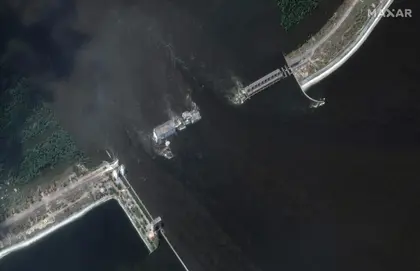What’s the latest?
The United Kingdom – one of Ukraine’s staunchest allies – said on Wednesday it was unwilling to apportion blame right now and would “err on the side of caution on this one.”
JOIN US ON TELEGRAM
Follow our coverage of the war on the @Kyivpost_official.
Speaking to journalists on the sidelines of a meeting at the OECD in Paris, British Foreign Secretary James Cleverly said: “We’re not going to say anything until we are completely armed with all the available facts.”
He did, however, say Russia bore ultimate responsibility as the destruction of the dam was a consequence of its full-scale invasion launched last year.
“It’s clear that this event is a direct repercussion of Russia’s invasion of Ukraine, and there’s nothing that Russia can do to hide that fact,” he said.
The US has taken an almost identical line, saying it is continuing to assess what happened, but adding: “Russia has no business to be [in Ukraine] in the first place. This dam was under Russia’s control, and they bear responsibility for the destruction caused by this war.”
But a Western official speaking on condition of anonymity, told AFP on Tuesday that the Western intelligence community, including the United States, was still assessing who was responsible but was leaning toward Russia.
The motive was also still being assessed, the official said, adding Russia possibly wanted to make it more difficult for Ukraine to conduct a river crossing, and to create a significant humanitarian challenge.

Thinking Out Loud – Where We’re at, What’s at Stake, and What Ronald Would Have Said
Why all the caution?
Due to the ongoing destruction, floodwaters and humanitarian disaster still unfolding on the ground, a detailed examination of the dam itself has yet to take place.
As such, the international community is unwilling to make any definitive statements on who is responsible or even if the dam was definitely blown up.
What’s the alternative to an explosion?
Structural failure, though experts have concluded this is unlikely even if it cannot be ruled out definitively at this stage.
A report in The New York Times quoted experts as saying that the dam had sustained damage due to military operations previous to its collapse but that this was unlikely to have been sufficient to cause what happened this week.
They also said the pattern in which it collapsed – first in the middle with more falling throughout the day – was inconsistent with this theory.
They also said that based on the available evidence, a blast within an enclosed space inside the working area of the dam would cause the most damage, whereas external detonations – such as by targeted missile or artillery strikes – would only exert a fraction of the force necessary to breach it.
Why is this important?
Two countries more than willing to apportion blame right now are Ukraine and Russia but their versions of events differ greatly.
Ukraine has accused Russia of mining the dam and blowing it up, while Russia has accused Ukraine of destroying it with long-range strikes.
The experts’ view would support Ukraine’s claims.
Undeterred and in his first public comments on the disaster, President Putin called it a “barbaric act,” telling Turkish leader Recep Tayyip Erdogan in a phone call that the breach “has led to a large-scale environmental and humanitarian catastrophe.”
NATO Secretary General Jens Stoltenberg said he will chair a meeting Thursday of an emergency coordination panel with Ukraine on the “outrageous destruction” of the dam.
You can also highlight the text and press Ctrl + Enter






